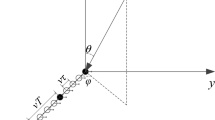Abstract
The approximate maximum likelihood (AML) algorithm shows promises for joint estimations of acoustic source spectrum and direction-of-arrival (DOA). For the multisource case, the AML algorithm remains feasible as one considers an alternating projection procedure based on sequential iterative search on single source parameters. In order to perform multisource beamforming operations, earlier, we used a two-dimensional (2D) sensor array with 2D AML to obtain the DOA estimations for sources in the far field of the array. Now, the 3D AML algorithm enables a 3D sensor array to collect acoustic data for estimation of DOA represented in azimuth and elevation angles. In this paper, we consider two acoustic sources being simultaneously active and derive Cramér-Rao bound (CRB) on DOA estimation given by a 3D array. Also, we compare the two-source DOA estimation results of 2D AML and 3D AML, respectively. To construct reasonable constraints on sensor topology, we adopt the concept of isotropic array and decouple the interplay between azimuth and elevation angle variations. The 3D AML algorithm exhibits superior spatial separation over its 2D counterpart for multiple sources located at different azimuth and elevation angles. Although the 3D AML algorithm requires more demanding computational complexity, we have developed a number of efficiency enhancements to reduce the loading for the grid search.
Similar content being viewed by others
References
C. H. Knapp, G. C. Carter. The generalized correlation method for estimation of time delay[J]. IEEE Transactions on Acoustics, Speech and Signal Processing, 1976, 24(4): 320–327.
H. C. Schau, A. Z. Robinson. Passive source localization employing intersecting spherical surfaces from time-of-arrival differences[J]. IEEE Transactions on Acoustics, Speech and Signal Processing, 1987, 35(8): 1223–1225.
Y. T. Chan, K. C. Ho. A simple and efficient estimator for hyperbolic location[J]. IEEE Transactions on Acoustics, Speech and Signal Processing, 1994, 42(8): 1905–1915.
M. S. Brandstein, J. E. Adcock, H. F. Silverman. A closed-form location estimator for use with room environment microphone arrays[J]. IEEE Transactions on Acoustics, Speech and Signal Processing, 1997, 45(1): 45–50.
J. Krolik, M. Eizenman. Minimum variance spectral estimation for broadband source location using steered covariance matrices[C]// Proceedings of International Conference on Acoustics, Speech, and Signal Processing. New York: IEEE, 1988: 2841–2844.
B. Friedlander, A. J. Weiss. Direction finding for wide-band signals using an interpolated array[J]. IEEE Transactions on Acoustics, Speech and Signal Processing, 1993, 41(4): 1618–1634.
J. Chen, R. Hudson, K. Yao. Maximum-likelihood source localization and unknown source localization estimation for wideband signals in the near-field[J]. IEEE Transactions on Signal Processing, 2002, 50(8): 1843–1854.
P. Bergamo, S. Asgari, H. Wang, et al. Collaborative sensor networking towards real-time acoustical beamforming in free-space and limited reverberance[J]. IEEE Transactions on Mobile Computing, 2004, 3(3): 211–224.
S. M. Kay. Fundamentals of Statistical Signal Processing: Estimation Theory[M]. Englewood Cliffs: Prentice-Hall, 1993.
I. Ziskind, M. Wax. Maximum likelihood localization of multiple sources by alternating projection[J]. IEEE Transactions on Acoustics, Speech and Signal Processing, 1988, 36(10): 1553–1560.
U. Baysal, R. L. Moses. On the geometry of isotropic arrays[J]. IEEE Transactions on Signal Processing, 2003, 51(6): 1469–1478.
A. M. Ali, S. Asgari, T. C. Collier, et al. An empirical study of collaborative acoustic source localization[J]. Journal of Signal Processing Systems, 2009, 57(3): 415–436.
Author information
Authors and Affiliations
Corresponding author
Additional information
This work was partly supported by the National Science Foundation (NSF) Center of Embedded and Network Sensing Program (No. CCR-012), NSF (No. EF-0410438), University of California Discovery grant sponsored by ST Microelectronics, a UCLA faculty research grant to DTB, and the MITWaveScope Project of NSF.
Juo-Yu LEE is currently a Ph.D. candidate in University of California, Los Angeles (UCLA). His research interests include data fusion, and the interplay of signal processing and networking.
Ralph E. HUDSON received his B.S. degree from University of California, Berkeley, in 1960, and Ph.D. from U.S. Naval Postgraduate School, in 1966. He served in U.S. Navy from 1960 to 1973, working on naval aircraft electronic warfare systems. From 1973 to 1993, he worked on airborne radar digital signal processing in Hughes Aircraft. He has been consultant and research associate at UCLA since 1993 to present. His research interests include signal and array processing, and synthetic array radar system design and signal processing.
Kung YAO received his B.S. (highest honors) and Ph.D. degrees in Electrical Engineering from Princeton University. Currently, he is a distinguished professor in the Electrical Engineering Department of UCLA. He was an assistant dean at the UCLA School of Engineering and Applied Science from 1985 to 1988. From May to June 2007, he was a Royal Society Kan Tong Po Visiting Professor at HK Polytechnic University. His research interests include acoustic/seismic array processing, sensor system, wireless communication theory and system, and systolic array algorithm and systems. He has published over 250 journal and conference papers. Dr. Yao received the IEEE Signal Processing Society’s 1993 Senior Award in VLSI Signal Processing and the 2008 IEEE Communications Society/Information Theory Society Joint Paper Award. He has served as an associate editor of IEEE Transactions on Information Theory, IEEE Transactions on Signal Processing, IEEE Transactions on Circuits and Systems, IEEE Communication Letters, etc. He is a life fellow of IEEE.
Rights and permissions
About this article
Cite this article
Lee, JY., Hudson, R.E. & Yao, K. Exploiting AML algorithm for multiple acoustic source 2D and 3D DOA estimations. J. Control Theory Appl. 9, 34–43 (2011). https://doi.org/10.1007/s11768-011-0264-3
Received:
Published:
Issue Date:
DOI: https://doi.org/10.1007/s11768-011-0264-3




